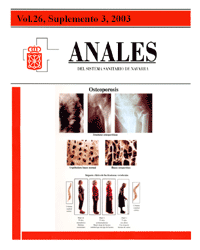Bone mineral density measurement techniques
Keywords:
Densitometría ósea. Técnicas de medida.Abstract
Different techniques for measuring bone mass density developed in the last years are revised. Single and dual fotonic absorciometry are now outdated by the use of single and dual x-ray absorciometry which don’t need an isotope source. The most widely used technique now is the dual energy x-ray asbsorciometry , specially the ones who analyse lumbar spine and hip. It is an accurate and precise tool and has proved to be a good predictor of fractures. Nevertherless, peripheral densitometers based on dual energy x-ray or on broadband ultrasonic attenuation, have also proved to be of utility. Quantitative computed tomography is the only three-dimensional densitometer available, capable to selectively measure cortical or trabecular bone. It has the inconvenient of the high radiation and cost. We argue about advantages and disadvantages of the different techniques of bone mass measurements. Lastly, we revise the indications of densitometry. There are not unanimous criteria about this question, but different organisms and scientific societies have elaborated recommendations based on risk factors of osteoporosis and fracture, that could be of utility in clinical practice.Downloads
Downloads
Published
How to Cite
Issue
Section
License
La revista Anales del Sistema Sanitario de Navarra es publicada por el Departamento de Salud del Gobierno de Navarra (España), quien conserva los derechos patrimoniales (copyright ) sobre el artículo publicado y favorece y permite la difusión del mismo bajo licencia Creative Commons Reconocimiento-CompartirIgual 4.0 Internacional (CC BY-SA 4.0). Esta licencia permite copiar, usar, difundir, transmitir y exponer públicamente el artículo, siempre que siempre que se cite la autoría y la publicación inicial en Anales del Sistema Sanitario de Navarra, y se distinga la existencia de esta licencia de uso.








